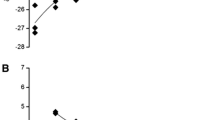Abstract
Isotopic analysis has become an important tool in the study of lateral links between ecosystems. The isotopic composition of carbon in terrestrial and aquatic primary producers can differ significantly, which provides an opportunity to identify the “marine” or “freshwater” carbon in the tissues of terrestrial animals. We measured the isotopic composition of C and N in tissues of soil invertebrates and estimated the proportion of “aquatic” carbon in the energy budget of terrestrial food webs at different distances from the Black Sea and a freshwater lake. Terrestrial predators are actively subsidized with carbon from the Black Sea to distance of up to about 50 m. The carbon subsidy from the freshwater lake is significant in the zone extending no farther than the forest border (ca. 15 m). Thus, the effect of allochthonous organic matter on terrestrial communities in both cases manifests itself only in a relatively narrow coastal strip.
Similar content being viewed by others
References
Akamatsu, F., Toda, H., and Okino, T., Food source of riparian spiders analyzed by using stable isotopes, Ecol. Res., 2004, vol. 19, pp. 655–662.
Anderson, W.B. and Polis, G.A., Marine subsidies of island communities in the Gulf of California: Evidence from stable carbon and nitrogen isotopes, Oikos, 1998, vol. 81, pp. 75–80.
Chahartaghi, M., Langel, R., Scheu, S., and Ruess, L., Feeding guilds in Collembola based on nitrogen stable isotope ratios, Soil Biol. Biochem., 2005, vol. 37, pp. 1718–1725.
Collier, K.J., Bury, S., and Gibbs, M., A stable isotope study of linkages between stream and terrestrial food webs through spider predation, Freshw. Biol., 2002, vol. 47, pp. 1651–1659.
Colombini, I., Brilli, M., Fallaci, M., et al., Habitat partitioning and trophic levels of terrestrial macroinvertebrates of a Tyrrhenian coastal ecosystem (Grosseto, Italy), Sandy Beaches and Coastal Zone Management: 5th Int. Symp. Rabat, Morocco, 2011, vol. 6, pp. 25–35.
France, R.L., Relationships between DOC concentration and epilithon stable isotopes in boreal lakes, Freshw. Biol., 1999, vol. 41, pp. 101–105.
Gladyshev, M.I., Arts, M.T., and Sushchik, N.N., Preliminary estimates of the export of omega-3 highly unsaturated fatty acids (EPA + DHA) from aquatic to terrestrial ecosystems, in Lipids in Aquatic Ecosystems, Arts, M.T., Brett, M.T., and Kainz, M.J., Eds., New York: Springer, 2009, pp. 179–209.
Goncharov, A.A., Kuznetsov, A.I., D’yakov, L.M., and Tiunov, A.V., Trophic connections of soil arthropods with aquatic ecosystems in the Oka Nature Reserve according to data of isotope analysis, Izv. Penz. Gos. Ped. Univ. im. V.G. Belinskogo, 2011, no. 25, pp. 337–344.
Gongalsky, K.B. and Kuznetsova, D.M., The fauna and communities of wood lice (Isopoda, Oniscidea) in the Abrau Peninsula, the Northwestern Caucasus, Zool. Zh., 2011, vol. 90, no. 80.
Gongalsky, K.B., Pokarzhevskii, A.D., and Savin, F.A., Soil macrofauna of sub-Mediterranean ecosystems in the Abrau Peninsula, the Northwestern Caucasus, Zool. Zh., 2006, vol. 85, no. 7, pp. 813–819.
Gratton, C., Donaldson, J., and Vander-Zanden, M.J., Ecosystem linkages between lakes and the surrounding terrestrial landscape in Northeast Iceland, Ecosystems, 2008, vol. 11, pp. 764–774.
Hagar, J.C., Li, J., Sobota, J., and Jenkins, S., Arthropod prey for riparian associated birds in headwater forests of the Oregon Coast Range, For. Ecol. Manag., 2012, vol. 285, pp. 213–226.
Henschel, J.R., Mahsberg, D., and Stumpf, H., Allochthonous aquatic insects increase predation and decrease herbivory in river shore food webs, Oikos, 2001, vol. 93, pp. 429–438.
Hoefs, J., Stable Isotope Geochemistry, 2nd ed., New York: Springer, 1980. Translated under the title Geokhimiya stabil’nykh izotopov, Moscow: Mir, 1983.
Ivanov, A.N., Bochkarev, Yu.N., Kozlov, D.N., and Khaug, A.A., Basic natural features of the Abrau Peninsula, in Priroda poluostrova Abrau: Sb. nauch. tr. (The Nature of the Abrau Peninsula: Collected Scientific Papers), Moscow: Mosk. Gos. Univ., 2000, pp. 4–14.
Jackson, J.K. and Fisher, S.G., Secondary production, emergence, and export of aquatic insects of a Sonoran desert stream, Ecology, 1986, vol. 67, pp. 629–638.
Kato, C., Iwata, T., Nakano, S., and Kishi, D., Dynamics of aquatic insect flux affects distribution of riparian webbuilding spiders, Oikos, 2003, vol. 103, pp. 113–120.
Korobushkin, D.I., Gongalsky, K.B., and Tiunov, A.T., Structure of terrestrial and riparian invertebrate communities in the taiga zone of the Kola Peninsula according to data of δ13C and δ15N analysis, Izv. Penz. Gos. Ped. Univ. im. V.G. Belinskogo, 2011, no. 25, pp. 353–357.
Lundberg, J. and Moberg, F., Mobile link organisms and ecosystem functioning: Implications for ecosystem resilience and management, Ecosystems, 2003, vol. 6, pp. 87–98.
Paetzold, A., Lee, M., and Post, D.M., Marine resource flows to terrestrial arthropod predators on a temperate island: The role of subsidies between systems of similar productivity, Oecologia, 2008, vol. 157, pp. 653–659.
Perel’man, A.I., Geokhimiya landshafta (Landscape Geochemistry), 2nd ed., Moscow: Vysshaya Shkola, 1975.
Peterson, B.J. and Fry, B., Stable isotopes in ecosystem studies, Ann. Rev. Ecol. Syst., 1987, vol. 18, pp. 293–320.
Polis, G.A. and Hurd, S.D., Extraordinary high spider densities on islands: Flow of energy from marine to terrestrial food webs and the absence of predation, Proc. Natl. Acad. Sci. U. S. A., 1995, vol. 92, pp. 4382–4386.
Polis, G.A., Anderson, W.B., and Holt, R.D., Toward an integration of landscape ecology and food web ecology: The dynamics of spatially subsidized food webs, Ann. Rev. Ecol. Syst., 1997, vol. 28, pp. 289–316.
Post, D.M., Using stable isotopes to estimate trophic position: Models, methods, and assumptions, Ecology, 2002, vol. 83, pp. 703–718.
Sabo, J.L. and Power, M.E., River-watershed exchange: Effects of riverine subsidies on riparian lizards and their terrestrial prey, Ecology, 2002, vol. 83, pp. 1860–1869.
Safronova, I.N., Yurkovskaya, T.K., Miklyaeva, I.M., and Ogureeva, G.N., Zony i tipy poyasnosti rastitel’nosti Rossii i sopredel’nykh gosudarstv, masshtab 1: 8000000. Karta; poyasnitel’nyi tekst i legenda k karte (Patterns and Types of Vegetation Zonality in Russia and Neighboring Countries, Scale 1: 8000000: Map. Explanatory Text, and Legend), Moscow: Mosk. Gos. Univ., 1999.
Sanzone, D.M., Meyer, J.L., Marti, E., et al., Carbon and nitrogen transfer from a desert stream to riparian predators, Oecologia, 2003, vol. 134, pp. 238–250.
Seifert, L.I. and Scheu, S., Linking aquatic and terrestrial food webs: Odonata in boreal systems, Freshw. Biol., 2012, vol. 57, pp. 1449–1457.
Semenyuk, I.I. and Tiunov, A.V., Isotopic signature (15N/14N and 13C/12C) confirms similarity of trophic niches of millipedes (Myriapoda, Diplopoda) in a temperate deciduous forest, Biol. Bull. (Moscow), 2011, no. 3, pp. 283–291.
Sergeeva, T.K., Byzova, Yu.B., and Uvarov, A.V., Invertebrates inhabiting dead seaweed beds on islands of the Kandalaksha Gulf, in Pochvennaya fauna Severnoi Evropy (The Soil Fauna of Northern Europe), Moscow: Nauka, 1987, pp. 69–74.
Tiunov, A.V., Stable isotopes of carbon and nitrogen in soil ecological studies, Biol. Bull. (Moscow), 2007, no. 4, pp. 395–407.
Vanderklift, M.A. and Ponsard, S., Sources of variation in consumer-diet δ15N enrichment: A meta-analysis, Oecologia, 2003, vol. 136, pp. 169–182.
Vernadsky, V., Zhivoe veshchestvo (The Living Matter), Moscow: Nauka, 1978.
Author information
Authors and Affiliations
Corresponding author
Additional information
Original Russian Text © D.I. Korobushkin, 2014, published in Ekologiya, 2014, No. 3, pp. 221–229.
Rights and permissions
About this article
Cite this article
Korobushkin, D.I. Role of allochthonous carbon in the energy of terrestrial invertebrate communities at different distances from the Black Sea and a freshwater lake (Isotopic Evidence). Russ J Ecol 45, 223–230 (2014). https://doi.org/10.1134/S1067413614030060
Received:
Published:
Issue Date:
DOI: https://doi.org/10.1134/S1067413614030060




